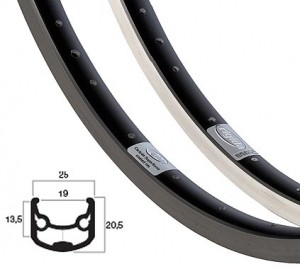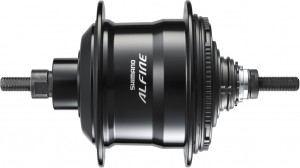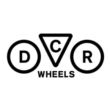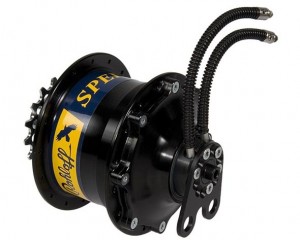The full range of Rohloff hubs is avaiable to order. All prices are the RRP less 10% which makes DCR Wheels very competitive for Rohloff builds of all flavours. There is a lot of options to choose from, so make sure you get the right hub. Generally I recommend disc brake compatible versions as it helps to future proof the hub, going for a solid spindle version will also increase compatibility in the future. Rohloff have a speedhub finder on their website which is very helpful, but if you want any advice about ordering a hub, please get in touch.
The Rohloff hub is one of the most expensive in the world. Partly because it is manufactured to a high standard but mainly because of what it is expected to do. The Rohloff has 14 internal hub gears. This means you have no need for: external cassette, front mechanism, rear mechanism, front shifter or more than one front chainring. Just one simple shifter that can be used stationary or during pedalling. No-one manufactures a hub that has 14 internal gears apart from Rohloff.
The hubs are made with German precision. The gears are an even 13.6% spacing with a total range of 526%. When using a double or triple chainset at the front, you find yourself entering into different ranges of gears which do overlap. So when you have 27 gears they are not 27 individual gears. The smallest chainring at the front with the smallest cog at the back is a considerably harder gear than the middle ring at the front and the largest at the back. The Rohloff has a straightforward shift up or down system. There is no complex arranging of gears and there are no ‘inappropriate’ gears like those found with derailleur systems (when the chainline is far out, or problematic rear mechanisms struggling to cope with the differential in chain length).
Rohloffs do come in at a weighty 1.8kg per hub, however you need to consider how much kit is packed into that hub. There is considerable weight saved by not having a rear cassette or mechanism and so forth. However because of the weight, the hub is an inappropriate choice for any weight weenie, particularly when you consider the additional weight as a result of the rotational of the hub.
Rohloff are not concerned about this because their key considerations in their engineering was life expectancy and maintenance. Being externally single speed means that the chain-line is always perfect putting less strain on your chain and improving its longevity. It also allows for a wider chain which helps to improve life-expectancy. They also have the gears in an oil bath which allows for very irregular service and the oil can be changed without dismantling the hub. The idea behind the Rohloff is essentially you never need to maintain the internals, you can use the hub for tens of thousands of miles before any internal work will need doing.
Another important feature for Rohloff it that the hub builds into a stronger wheel. Rear wheels that have external gears are normally dished which means particularly high tensions on one set of spokes and particularly low tensions on the other set. With a Rohloff, the wheel is undished which means all tensions can be even. Rohloff claim that a 32h rohloff wheel has the equivalent strength to a 40h conventional rear wheel.
Unfortunately for those looking to build with a Rohloff there are a number of Rohloff specific considerations. Rohloff recommends that their hubs be built up with Sapim Race spokes. They will tolerate the use of spokes with similar dimensions such as DT Competitions. Crucially they want a double butted spoke, that is of a reasonable mid section and most importantly has a 2mm diameter at the elbow. Their hub shell is drilled in such a way that fatigue would be caused from a larger spoke. Equally anything smaller would be a poor fit.
They have also specified that the spokes need to be laced in a two cross pattern.  The size of the hub means that three cross lacing would have the spokes come out of the hub at an extreme angle which can cause wear on them. Additionally, when the spoke meets the rim it is at a considerable angle and this causes the spoke to bend and in time fatigue. Because of this particular problem Rigida have made a Rohloff specific rim called the Andra 30. (I sell the basic version for £35 or the Tungsten Carbide coated version for £85). They are a hugely tough rim and importantly are drilled so as to prevent kinked spokes. These rims have to be laced in a particular way because not only is each hole side specific, it is directional as well. This is the only rim recommended by Rohloff in their builds and it is only available in 26″. However if you are building a 700c wheel, the angle is less severe and a conventional rim can be used.
The size of the hub means that three cross lacing would have the spokes come out of the hub at an extreme angle which can cause wear on them. Additionally, when the spoke meets the rim it is at a considerable angle and this causes the spoke to bend and in time fatigue. Because of this particular problem Rigida have made a Rohloff specific rim called the Andra 30. (I sell the basic version for £35 or the Tungsten Carbide coated version for £85). They are a hugely tough rim and importantly are drilled so as to prevent kinked spokes. These rims have to be laced in a particular way because not only is each hole side specific, it is directional as well. This is the only rim recommended by Rohloff in their builds and it is only available in 26″. However if you are building a 700c wheel, the angle is less severe and a conventional rim can be used.
Another important consideration when building with a Rohloff is stresses on the axle. If the axle receives too strong a force it will go out of alignment causing the bearings to lock up. This could occur when the wheel is being stressed or when seating spokes properly. Heed caution when undertaking these necessary steps.
One last Rohloff specific trait is that the leading spoke needs to be facing inwards, in contrast to the trailing spoke which needs to be facing outwards. It is also important that the spokes to not cross over the hub cap fixing screws. Diagrams are available on Rohloff’s website.
What about the Alfine 11?
It is probably a good time to mention Shimano’s new Alfine 11 hub and how that compares with the Rohloff. Well, it is really quite new, at this point they could all be recalled unlike the Rohloff hubs that have stood the test of time. However if anyone is going to get it right straight away it is Shimano. They have moved away from the technology that they used in the Alfine 8 in favour of Rohloff’s oil bath system. They have also made a hub that is less than half the price of the Rohloff. It is also a little bit lighter than the Rohloff and smaller. It also comes with a fairly standard rapid fire shifter. This uses a normal cable and shifts in the same way that modern Shimano MTB shifters do.
By contrast, it has 11 rather than 14 gears. With a range of 408.5% – less than the Rohloff. The Rohloff also shifts in even 13.6% increments, whereas the Alfine has a particularly easy first gear followed by a jump to second where it proceeds in fairly even increments of a similar percentage to the Rohloff hub.
The Rohloff hub does offer more than the Alfine, however, with such a big price disparity and a good number of 2011 bikes coming with Alfine 11, Rohloff may have their first serious piece of competition.
There is a lot more information available about choosing wheelsets, building wheels and selecting component parts as well as information on repairing wheels in Bicycle Wheelbuilding: The Manual an ebook which is available to purchase exclusively here:
https://dcrwheels.co.uk/products-page/product-category/bicycle-wheelbuilding-the-manual/


